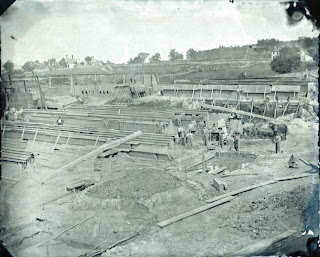Iron City Tool Works of Pittsburgh, PA, was a medium-sized manufacturer of hand tools for railroads, mines, blacksmithing, and stone masonry. Their logo, stamped deeply into all their tools, is a 6-pointed star with IRON CITY inside the star. Older Iron City tools may also say WARRANTED CAST STEEL, as did tools of many makers. Here are several
Iron City Tool Works catalogs.
 |
| Pittsburgh directory 1863-64 |
According to Pittsburgh city directories and Ancestry.com, the business began about 1862 as Kloman & Co. iron mill in Millvale at the northeast edge of Pittsburgh. Brothers Anthony (originally Antonius) Kloman (1826-1897) and Andrew (Andreas) Kloman* had learned forging as boys in Prussia. After a year, they separated the business into 2 firms. Andrew started an iron and steel rolling mill and went on to an association with Thomas and Andrew Carnegie. Anthony began making tools using the name Kloman & Co., Iron City Forge. The tool works had a succession of partners through 1878. From 1864-66 it was Kloman & Phipps, from 1866-67 it was Kloman & Voelker, in 1867 it changed to Kloman, Buerkle & Co, and in 1872 it was Kloman, Park & Co. The first use of the secondary name Iron City Tool Works is in the 1868-69 directory.
 |
| George F. Konold & son, 1920 |
In 1879, Anthony Kloman gave up control of Iron City Tool Works, and the business became Park, Long & Co., with steel men David E. Park and Joseph D. Long. This lasted about 2 years, and the firm reorganized about 1881 as Iron City Tool Works, Limited. Christian Konold (1833-1888) became superintendent, and his family would eventually own the company. Christian had been hired in 1868 at Kloman, Buerkle & Co. as a hammerman, and later his 2 sons joined as forgers. After Christian's death in 1888, his son George F. Konold (1864-1924) was superintendent for 23 years. George's brother William F. Konold (1866-1933) followed in the position, and at his death had worked for Iron City for 57 years.
William H. Hays (1847-1926), a Pittsburgh bookkeeper, managed the business beginning in 1881. He was chairman from 1887, or earlier, to 1926, and his son William H. Hays, Jr. (1877-1966) was treasurer in 1903. Son John Crossan Hays (1891-1968) followed his brother as treasurer. Nothing else about Mr. Hays's business background or his financial stake in Iron City is known. The house Mr. Hays built in the late 1880s at
5200 Westminster Place suggests that he was already wealthy or that Iron City Tool Works was very profitable for him.
 |
| Pittsburgh, 1882 map by G.M. Hopkins |
The original tool works was on Butler St. (renamed Railroad St.) between Smith (30th St.) and Morton (28th St.), then at Butler St. and Wilson St. (32nd St.). In 1869 they were still at 32nd Street and Railroad St. This building expanded over the next 30 years until it occupied almost the whole block from 32nd to 33rd. By 1890 there was a second building at 32nd St. and Smallman St. Iron City suffered a fire in 1903 and rebuilt on the same spot, remaining there until 1958.
Apparently Iron City sold to wholesalers and did little advertising, and surviving catalogs are rare. I have located their
1891 product line in their New York agent's catalog, and extracted those pages for you. The Pittsburgh Commodity Index of 1913 lists Iron City's products:
bars (17 styles)
blacksmith’s tools
breast augers
caulking tools
chisels (17 styles), including brick, splitting, and stone cutters’ chisels
coal drills
coopers’ tools
hammers (18 styles), including bush, hand drilling, macadam, napping, paving, spalling, stone, and other hammers
hoes (6 styles)
mattocks (9 styles)
 |
| Iron City 6-lb. spalling hammer |
mauls (6 styles)
mining machine bits
picks (19 styles)
plow anvils
punches (5 styles)
rail forks
sledges (8 styles), including limestone, pein and flat face stone, stone
spike pullers
stone workers’ axes
swages (4 styles)
tongs (3 styles)
track tools
track wrenches
vises (6 styles)
wedges (10 styles), including stone wedges
Warren Tool Corp., founded in 1911 by George F. Konold, took over Iron City in 1958. Warren made many of the tools that Iron City did. In 1994 Warren Tool was sold to Wilton Corp. of Palatine, IL, and continued to operate as Warren Tool Group until Walter Meier Holding Company AG bought Wilton in 2002. Iron City's former building at 3201 Smallman St. still stands.
 |
| Iron City Tool products, 1953 |
 |
| Iron City Tool advertisement, 1908 |
 |
| Early Iron City Tool Works post vise, no star logo, photos by Chris Mills |



















































